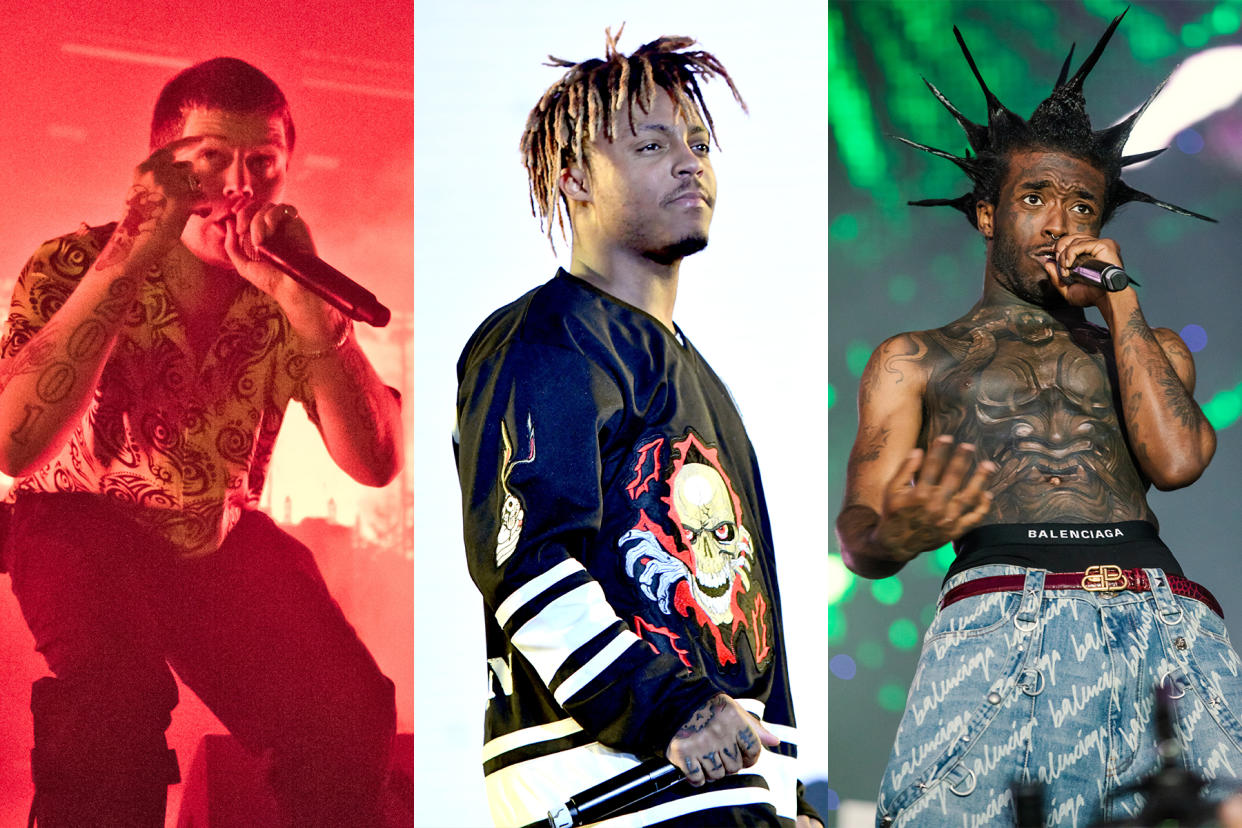A Sign of the Times: How Gen Z Turned Rap Emo

In 2017, Lil Uzi Vert’s “XO TOUR Llif3” peaked at Number Seven on the Billboard Hot 100. The song explored themes of substance abuse and suicide, finding a loyal audience in young listeners. In the chorus, by now etched in rap infamy, Uzi sings, “Push me to the edge/All my friends are dead,” with a bouncy, almost cartoonish swing. The track’s emotional dialogue marked a shift in hip-hop. Emo rap, a subgenre that grew in popularity on SoundCloud during the 2010s, was becoming mainstream.
The movement started with young rappers uploading vulnerable tracks to the internet and blending the production styles of hip-hop with the lyrical and aesthetic concerns typically found in emo rock. Lil Uzi, who recently announced their gender pronouns as “they/them,” currently sports a towering, spiked hairstyle reminiscent of Hot Topic advertisements. And while rappers like Uzi, Yung Lean, and Trippie Redd occupy the more mainstream end of the genre, a focus on mortality is a fixture even in the most-niche corners of the theme.
More from Rolling Stone
Rolling Loud: Kid Cudi Walks Offstage as Kanye Appears With Lil Durk
Denzel Curry Offers a Glimmer of Hope With 'Walkin' on 'Fallon'
Lil Uzi Vert Drops Surprise 'I Know' Song Ahead of 'Red & White' EP
Since 2018, emo rap has become the fastest-growing genre on Spotify, and with the genre growing in popularity on TikTok, Gen Z is partly responsible for the speed of its rise. “It’s definitely a younger genre. I think fans start as early as 10 or 11 years old, because that’s generally when kids are starting to get the iPhone or at least hearing about those rap stars at school,” says Justin Staple, a music-video and film director based in Los Angeles.
In his upcoming documentary, American Rapstar, Staple explores the SoundCloud rap phenomenon and the young rappers who have emerged within the past few years. But, he claims, emo rap’s origins go further back. Long before the genre found its hub across online audio-distribution platforms, more vulnerable-sounding rap from artists like Eminem, Kid Cudi, and Odd Future showed hip-hop fans that rap music was taking a different approach. Decades of tracks consisting of emotionally-charged lyrics with rock-inspired beats found in rap, metal, and rock music influenced the genre’s early beginnings. In fact, many emo rappers have shared growing up listening to rock groups like Nirvana, Fall Out Boy, and Black Sabbath.
Staple believes it took off due to a rise in streaming music online, which tends to be an individualized consumption as opposed to communal. It creates space for sad tracks to be absorbed alone, in quietness, without fear of judgment from others. “Traditionally, rap was more party music and journalism of the streets and street poetry. But I think now there’s been a sense of isolation and uncertainty about where culture is headed, and a lot of the subgenres and subcultures have moved on to the internet and not so much in the club,” Staple explains. “Since the music can be consumed by yourself, in your room, and not in a club setting with a DJ, it is probably more prone to be sad than party anthems.”
In a 2019 interview with The Guardian, to a question about where anguish in the genre stems from, late emo rapper Juice WRLD responded: “Everybody’s got pain. Depression, addiction, heartbreak: These are human characteristics.” According to a 2019 study, Gen Z and millennials are in general more anxious than previous generations. “There is a sense of despair and uncertainty about the future of the world of America. And also, especially with the pandemic, a sense of isolation and loneliness. A lot of that has given rise to this genre and sadness in a whole new way that music hasn’t seen before,” Staple says.
But fans and critics of the genre hold very differing views on its impact.
Some have critiqued the genre for its culture of drug use after the overdose deaths of some of its most prominent names, including Lil Peep and Juice WRLD. Some believe it promotes destructive habits and encourages suicidal ideations. In 2018, during a joint investigation by the New York Police Department and Drug Enforcement Agency, emo-rap lyrics were blamed for “glorifying” fentanyl and Xanax, directly influencing the opioid epidemic. “This investigation led us into the underbelly of emo rap and its glorification of opioid use,” said DEA Special Agent in Charge James J. Hunt.
Whether emo rap can be connected to the rise in drug abuse among teens is debatable, but what fans collectively express is the genre’s ability to make people feel connected in their pain, even if only for the duration of a track.
“Young people today are growing up in a world with spiking anxiety rates, spiking depression, and spiking addiction to social media,” Staple says. “At the same time, there’s an opioid epidemic, a gun-violence epidemic, and prescription drugs moving throughout high schools. Emo rap is kind of the answer to the intersection of all these issues at once.”
Best of Rolling Stone

